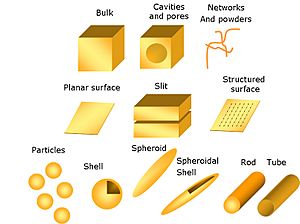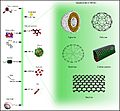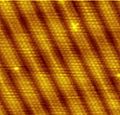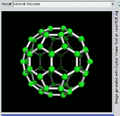Nanotechnology facts for kids
Nanotechnology is a super cool part of science and technology that deals with controlling tiny things. We're talking about stuff at the atomic and molecular level – that's about 100 nanometers across or even smaller!
To give you an idea of how small a nanometer is, imagine this: there are more nanometers in one inch than there are inches in 400 miles! Or, if you prefer metric, there are as many nanometers in a centimeter as there are centimeters in 100 kilometers. It's really, really tiny!
Nanotechnology helps us make products with these tiny parts. This includes things like tiny electronic devices, special materials called catalysts, and even super sensitive sensors.
Scientists and engineers from many different fields work together in nanotechnology. This includes people who study applied physics, materials science, chemistry, biology, and different types of engineering like chemical engineering and electrical engineering. They all team up to understand and create things on this incredibly small scale.
Most of the work in nanotechnology today focuses on making "nanoparticles." These are particles that are nanometer-sized and have special abilities. For example, they might scatter light in unique ways, absorb X-rays, or conduct electricity and heat differently. Some exciting, more "science fiction" ideas include trying to build tiny copies of bigger machines or creating new structures that can build themselves. Working with things this small, even single atoms, opens up a world of new materials and possibilities.
There's a lot of talk about the future of nanotechnology and its possible dangers. On one hand, it could lead to amazing new materials and tools for medicine, computers, and making clean electricity. For instance, it's helping design the next generation of solar panels and efficient lighting. On the other hand, because it's so new, there could be unknown problems. What if these tiny materials are bad for people's health or for nature? They might even affect the economy or big natural systems like Earth itself. Because of these concerns, some groups believe there should be rules about how nanotechnology is used.
Contents
How Nanotechnology Started
The idea of working with super small things began with a famous scientist named Richard Feynman. On December 29, 1959, he gave a talk called "There's Plenty of Room at the Bottom." In his talk, Feynman described how we could move individual atoms to build smaller tools and work at that tiny scale. He said that forces like surface tension would become very important.
Feynman's simple idea seemed possible. The actual word "nanotechnology" was first used by Professor Norio Taniguchi from Tokyo Science University in a paper in 1974. He said that nanotechnology was about changing materials one atom or one molecule at a time.
In the 1980s, Dr. K. Eric Drexler really pushed these ideas forward. He talked and wrote a lot about how important nano-scale events were. His book, "Engines of Creation: The Coming Era of Nanotechnology" (1986), is often seen as the first major book on nanotechnology.
Nanotechnology and nanoscience really took off with two big breakthroughs. One was the start of "cluster science," which studies groups of atoms. The other was the invention of the scanning tunneling microscope (STM). This amazing microscope lets us see individual atoms! Soon after, new molecules made of carbon were found, like fullerenes in 1986 and carbon nanotubes a few years later. Scientists also learned how to make tiny semiconductor crystals. Many metal oxide nanoparticles are now used as "quantum dots," which are nanoparticles where the behavior of single electrons becomes important. In 2000, the United States started the National Nanotechnology Initiative to help develop this field even more.
Types of Nanomaterials
Nanomaterials can be sorted into different types based on their size and shape. We often classify them by how many dimensions they are "nano-sized" in. For example, some are nano in one dimension (like a very thin film), some in two (like a tiny wire), and some in three (like a tiny particle).
This classification helps us understand their different properties. These properties include how they scatter light, absorb X-rays, or conduct electricity and heat. Nanotechnology brings together many different subjects and affects many traditional technologies and scientific areas. It allows us to create new materials that can be scaled down to the size of individual atoms.
Cool Nanotechnology Facts
- One nanometer (nm) is 10−9 meters, which is 0.000,000,001 meters. That's one billionth of a meter!
- When two carbon atoms join together to make a molecule, the distance between them is about 0.12 to 0.15 nanometers.
- The famous DNA double helix is about 2 nanometers wide. This has led to a new field called DNA nanotechnology. In the future, we might be able to change DNA in amazing ways, which could lead to big changes in medicine and other areas.
- To understand the size difference, imagine a golf ball and the Earth. The difference in size between a nanometer and a meter is similar to that!
- One nanometer is about one twenty-five-thousandth the diameter of a human hair.
- Your fingernails grow about one nanometer every second!
How Nanomaterials Behave
At the nano scale, the physical properties of materials change a lot. For example, "quantum size effects" mean that electrons move differently in very small particles. Things like how strong a material is, how it conducts electricity, and how it interacts with light can all change when a large material is shrunk down to the nano size. This is super important for creating new technologies.
Nanomaterials and nanoparticles can also act as amazing catalysts. This means they can speed up chemical reactions and help produce better results compared to other catalysts.
Some of the most interesting changes happen when materials become nano-sized:
- Substances that usually block light can become transparent (like copper).
- Materials that are hard to burn can become flammable (like aluminum).
- Solids can turn into liquids at room temperature (like gold).
- Materials that don't conduct electricity can become conductors (like silicon).
- A material like gold, which normally doesn't react with other chemicals, can become a powerful chemical catalyst at nanoscales.
These special properties, which we only see at the nano scale, are one of the most exciting things about nanotechnology!
Images for kids
-
An image of a clean Gold surface, seen using a Scanning tunneling microscope. You can see the individual atoms!
-
This DNA tetrahedron is a tiny structure made by scientists using DNA nanotechnology. Each side is a DNA double helix.
-
A typical setup for an Atomic force microscope. A tiny tip moves over a surface, like a record player needle, but much smaller, to create an image.
See also
 In Spanish: Nanotecnología para niños
In Spanish: Nanotecnología para niños












